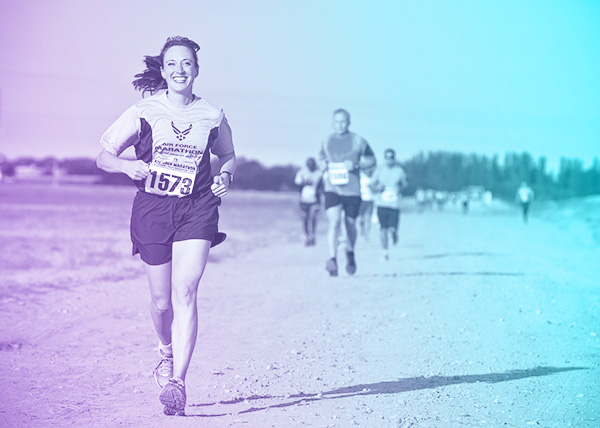Can You Get High Without Drugs?
If you’re in recovery, know someone in recovery, or have ever attended an anti-drug seminar, you’ve likely heard the catchphrase “get high on life.” It’s easy to dismiss these words as wishful thinking and exaggeration, but there’s truth to this common saying. Many everyday activities are scientifically proven to produce sensations in the brain that can be considered a high.
Are there differences between the highs brought on by mind-altering substances and highs from non-drug activities such as exercise? Of course. There would be no such thing as an opioid crisis if going for a run brought on the exact same effects as taking oxycodone.
However, there are real similarities in the brain effects of drugs and many non-drug activities. That means that quitting a drug doesn’t mean giving up happiness and euphoria entirely, even if that’s what it often feels like at first. Over time, many people in recovery find natural highs to be a pleasurable and important part of a sober lifestyle.



What Causes the Feeling of a High?
First, it’s important to examine what a ‘high’ actually is. Different drugs bring on many different sensations that all fall under this umbrella. One thing all drugs have in common, however, is that they manipulate naturally-occurring mechanisms in the brain that make us feel content, relaxed, alert or otherwise altered in some pleasurable way.
One of the human brain’s primary functions is to keep you alive. To accomplish this, the brain incentivizes various survival activities. Often, these activities are seeded in over many generations, so they may not be the best choices in the modern world.
Eating high-fat or high-sugar foods, for example, is important in a world where you may not be able to find food for days. Listening to a story can also trigger these reward pathways, as the lessons in the story may be the difference between surviving a dangerous encounter and not surviving it. In the modern day, spending a day playing video games has similar effects.
The brain rewards positive survival choices with natural, biological signals of strong happiness. These signals cause what we think of as a ‘high.’
How Do Reward Pathways Function in the Brain?
To make a person keep doing what will help them survive, the brain uses special chemicals called neurotransmitters. These include dopamine, serotonin and norepinephrine. They’re also hormones that can travel through the blood and affect the entire body.
When these chemicals come into contact with specialized neuroreceptor cells in the brain, these cells send electrical signals that make a person happy.
How Do Drugs Manipulate Reward Pathways?
All addictive drugs, from alcohol to methamphetamine to heroin, take advantage of these pathways. Drugs hijack them so that they’re no longer about survival. Instead, they cause the brain to release unnaturally high amounts of neurotransmitters whenever the drug enters the body.
This allows drugs to deliver a much more intense high than is possible from food, exercise, building relationships or the other positive behaviors these pathways are meant to encourage. An addictive drug can therefore feel like the only source of pleasure in a person’s life.
In addition, neuroreceptor cells aren’t meant to handle unnaturally high amounts of these chemicals. Similar to an overwhelmed customer service desk during a holiday rush, receptors quit under the stress, and the system grinds to a halt. This is why subsequent doses of a drug aren’t as pleasurable as a first high. Instead, a person begins to crave a drug even though it no longer feels very good.
The good news is that over time, much of this damage to the brain is reversible if a person gets clean and stays clean. Once neural pathways return to normal, non-drug activities can cause pleasurable feelings, again.
Do Activities Other Than Drugs Trigger These Pathways?
Many activities and sensations other than drugs trigger reward pathways. Though some of them are unhealthy, the vast majority are beneficial. Even the unhealthy choices aren’t nearly as destructive as drugs.
That means it’s still possible to get a ‘high’ after quitting a drug. As the brain’s reward pathways recover from addiction, everyday activities begin to feel more and more pleasurable. Here are twelve non-drug and alcohol activities that can give you a high.
12 Ways To Get High Without Drugs or Alcohol
1. Exercise
Exercise is the most common recommendation for a natural high because it’s one of the most intensively studied. The “runner’s high” many people talk about isn’t limited to running. Any moderate-to-high intensity exercise can release endorphins after 20-30 minutes of effort.
Did you know ‘endorphins’ is short for endogenous morphine? “Endogenous” means produced in the body, and morphine is a reference to how these chemicals suppress pain and stress, similar to the effects of morphine and other opioid drugs.
The catch is that low-intensity exercise, while beneficial, isn’t enough to release endorphins. Your body needs to be under real pressure before it resorts to these chemicals, which means exercising vigorously. Aim for a pace where you can breathe, you may be able to hold a conversation with some effort, but you aren’t able to sing a song. If you’re new to exercising, you may need to invest a month or two of training at lower intensities before you’re able to sustain this pace.
Running
Running requires minimal equipment, no gym membership, no classes and no special training. A pair of good shoes and a safe route are all you need for this form of exercise. In addition to endorphins, research shows that running releases endocannabinoids in the brain. These produce a similar effect to THC, the psychoactive chemical in cannabis.
Many would-be runners go too quickly starting out, so ease into this exercise with a couch to 5k program. Given some time, you can reliably achieve your “runner’s high” daily.
Dancing
If you find running boring, dancing is a great alternative that provides vigorous aerobic exercise as well as mental stimulation. Many drugs bring on a feeling of euphoria and lowered inhibition that inspires people to dance. Dancing while sober, instead, can be a powerful way to relieve stress and put distance between yourself and addiction.
Group Exercise Class
Joining a group class can help your achieve the moderately intense levels of exercise needed to release endorphins. Keeping pace with the instructor and other participants in an energetic setting may be easier than pushing through discomfort on your own.
2. Laughter
An easier way to release endorphins, as well as the neurotransmitters serotonin and dopamine, is to laugh. A large laughing fit is more likely to give you a natural high than a small chuckle. Keeping a list of comedy routines and videos guaranteed to make you laugh can incorporate bursts of deep laughter into your day.
3. Building Friendships
One of the main challenges of overcoming addiction is building a new network of friendships. If your friends are still using drugs, being around them can greatly increase your risk for relapse.
Making new friends is a great way to boost your brain’s levels of serotonin and dopamine. Joining clubs, volunteering or even getting involved in an online community can help you branch out and form important interpersonal connections that won’t risk your sobriety.
4. Eating Spicy Foods
Capsaicin is the molecule in chili peppers that produces a burning sensation on the tongue and lips. It binds to heat receptors and tells the brain you’re eating something dangerously hot, such as boiling liquid.
Over time, it’s possible to increase your tolerance for spicy food and enjoy this sensation. To your brain, though, it’s still incredibly stressful. Like difficult exercise, this stress inspires a release of endorphins that can be a substantial and long-lasting high if the food is spicy enough.
5. Meditation
Many people’s drug problems arise from an attempt to self-medicate for underlying mental health conditions. While meditation isn’t a substitute for mental healthcare, it can help manage many of these conditions without the use of drugs and alcohol. A five-minute guided meditation per day can not only release calming chemicals in the brain but also give you the tools to dismiss harmful intrusive thoughts.
Yoga and Moving Meditation
Meditation doesn’t have to mean sitting still. A yoga class can combine endorphin-releasing exercise with the calming effects of mindfulness. Many people find it easier to get into the habit of meditation when it’s paired with movement and instructions to occupy the mind.
6. Completing Meaningful Tasks
Dopamine, the brain’s pleasure chemical, is released when completing an array of meaningful tasks. If you’ve ever felt relief or even euphoria after cleaning a neglected room or getting a job, you’ve experienced a natural dopamine high.
Doing Good Deeds for Friends and Family
Addiction can alienate a person from healthy support networks in their lives. Cooking a meal or doing chores for friends and family members can both inspire a productive high and help rebuild these relationships.
Starting a Creative Pursuit
Channeling strong emotions into an artistic hobby can help process them in a healthy way. Additionally, looking over what you’ve accomplished or enjoying the sound of a new instrument you’ve picked up releases endorphins in the brain.
Holding Down a Job
While many people with addictions are able to mask their problems in daily life, for some, addiction leads to the loss of income and employment. While going to work may not be a pleasurable experience, being able to successfully hold down a job in your field can increase feelings of self-worth and cause the brain to release helpful chemicals.
Volunteering
Giving time and effort to charitable causes can help you build new friendships as well as give a dopamine high from knowing you did something productive.
7. Travel and Adventure
Taking a vacation is an expense that often isn’t possible when spending money to fuel an addiction. One benefit of getting clean is that your money can go towards leisure activities that improve your life and give you a natural high.
Sunshine and Relaxation
UV light from the sun stimulates the same endorphin release as vigorous exercise. Choosing a meditation retreat can help you remember the high of a vacation and apply the same principles of relaxation to your non-vacation lifestyle.
Extreme Sports
On the other end of the spectrum, high-intensity activities like surfing, roller coasters or ziplines deliver a potent rush of norepinephrine, the fight-or-flight chemical many stimulants like cocaine and methamphetamine release in the brain. While harmful stimulants keep the body in fight-or-flight long past what is healthy, a natural adrenaline rush tapers off without harming the body’s key systems.
8. Performing in Front of an Audience
Putting the brain in healthy situations of stress is a great way to release endorphins and other feel-good chemicals for a natural high. For many people, performing in front of an audience is one of those situations. Persevering through stage fright can give you a rush and foster new friendships at the same time.
Trying Stand-Up
A common saying in entertainment is that comedy equals tragedy plus time. This means that dark times in your past can be transformed if you frame them in a humorous light. Comics like Tig Notaro have made even the bleakest personal tragedies into hilarious and powerful stand-up routines.
Going to Booth Karaoke
Attending karaoke in bars can entail large amounts of alcohol and lead back into bad habits. However, private karaoke booths let you and a few friends — or even a person by themselves — sing along for an endorphin boost without the pressures of a large audience or a bar setting.
Sharing Written Work
If getting on stage is too nerve-wracking, consider sharing a poem or story with friends or in a positivity-focused writer’s group. Hearing positive feedback on creative work is a great way to receive a natural high that can last for days.
9. Listening to Music
Not all natural highs require intense commitment or effort. Simply putting on a favorite song releases endorphins, serotonin and dopamine in the brain. For an extra dopamine kick, put on a playlist of favorite songs while you tackle a difficult chore or cook a healthy meal.
10. Occasional Treats
Food creates powerful mood effects in the brain. While completely replacing the high of a drug with the boost of high-fat or high-sugar foods isn’t wise, a box of chocolate chip cookies is still a better choice than an addictive drug. It’s ok to indulge in sweets and favorite foods from time to time if you need a natural mood boost.
11. Acupuncture
Acupuncture is an ancient medical technique that involves placing needles in the skin at certain pressure points. While the idea of being stuck with needles can be frightening, there’s no reason to be wary of this practice. It isn’t painful and is clinically proven to release endorphins and naturally reduce pain levels throughout the entire body.
12. Adopting a Pet
Many of the natural highs on this list aren’t large, long-term commitments like adopting a pet. It’s important to ensure you’re ready and on stable footing before taking on an animal’s life as your responsibility. However, for many people recovering from addiction, celebrating their sobriety by adopting a pet helps boost their daily mood and keep them accountable.
The same feel-good hit of dopamine that comes from taking care of your chores and tasks kicks in when you feed, exercise or otherwise care for a pet. Cuddling or petting a cat or dog releases serotonin in the brain. Knowing that a living being is depending on you can be a powerful motivator to stay clean and sober.
How To Quit Drugs and Alcohol and Stay Clean
The natural highs on this list all release dopamine, endorphins, serotonin and other chemicals that deliver a similar effect to drugs. Granted, these effects are on a significantly smaller scale. Lifestyle changes alone aren’t enough to fight serious drug addiction. Professional help is an effective and proven way to get clean. From there, natural highs can become satisfying again.
Deciding to quit is an important first step, but quitting drugs without proper support can carry large risks. Some drugs, such as alcohol and heroin, have withdrawal symptoms that can seriously harm the body. Others, such as methamphetamines, cause impulsivity and reduced decision-making skills. These symptoms make relapse highly likely even if a person has every intention of quitting.
Clean Recovery Center’s three-phase program starts with inpatient monitoring to get past the hardest early stages of withdrawal. Then, professionals treat the underlying causes of addiction to help a person get clean. This can include therapy for underlying mental health issues, rebuilding belief systems and overcoming the guilt and shame that feed into drug addiction. Finally, outpatient monitoring and support strategies help to avoid relapses.
Recovery from drug addiction is possible with the right tools and treatment. Drugs can warp a person’s perception and cause them to neglect other areas of their life, but many people with addictions can enjoy the natural highs of life again after gaining their sobriety. Call us today at 888-330-2532 for more information on drug addiction, treatment options and how to stay clean.
Sources:
- https://recovery.org/5-ways-to-get-high-without-drugs-or-alcohol/
- https://goaskalice.columbia.edu/answered-questions/natural-highs/
- https://www.jasonwahler.com/wellness-blog/natural-highs
- #
- https://www.ncbi.nlm.nih.gov/pmc/articles/PMC4065474/
- https://www.health.harvard.edu/mind-and-mood/endorphins-the-brains-natural-pain-reliever
- https://www.pnas.org/doi/abs/10.1073/pnas.1514996112
- https://www.c25k.com/
- https://pubmed.ncbi.nlm.nih.gov/15135942/


